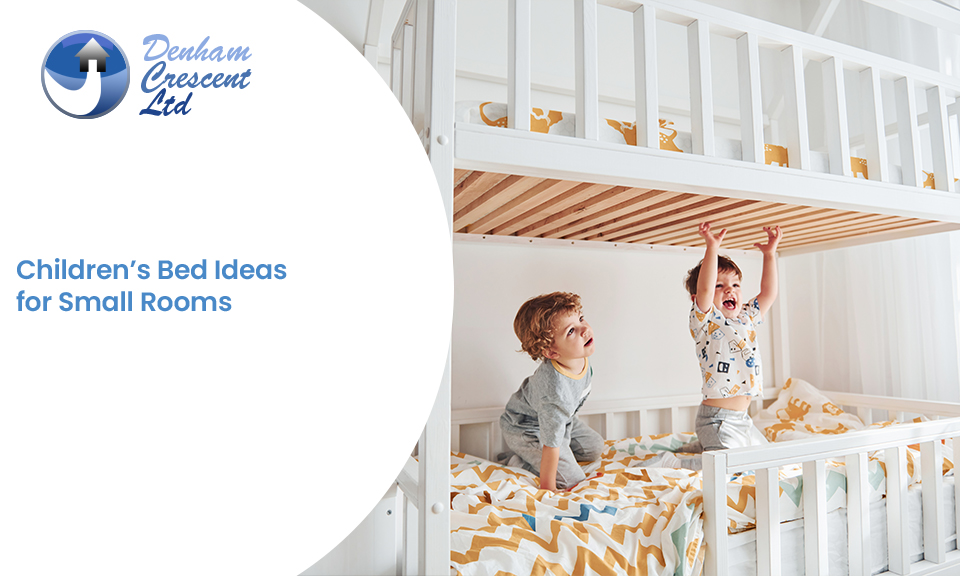Children’s Bed Ideas for Small Rooms
03, Oct, 2025
Thinking about designing your child’s bedroom, it’s exciting but challenging as well. Due to limited space, small rooms can quickly feel filled with toys, furniture, and storage boxes, leaving little room for your child to play, study, or relax. But this does not have to be difficult if you have the right design idea, every little inch of space can be saved and utilised.
Whether you’re working with a shared bedroom, a box room, or simply a home where storage is at a premium, there are plenty of clever solutions. We have compiled some of the best ideas in the market for 2026 to get the best comfort and peace of mind.
Bunk Beds for Shared Rooms
When two children share a room, bunk beds are a space-saving and cost-effective solution. They make sleeping areas vertically, leaving the floor clear for play, desks, or keeping clothes. Modern bunk beds are far more stylish and functional than in the past, often having:
Built-in drawers or under-bed storage.
Modern shelves for books and toys.
Pull-out trundles for sleepovers.
Safety is key with bunk beds. Make sure the top bunk has solid guardrails and that the ladder is safe and easy for your child to climb. For UK homes with standard ceiling heights, do check clearance so your child won’t bump their head sitting up.
Mid Sleepers and Cabin Beds
If ceiling height is limited, mid sleepers (sometimes called cabin beds) work best. These beds sit slightly higher than a standard bed, freeing up space beneath for storage or a desk. They are perfect for children in primary school who need places to keep toys, clothes, or school supplies neatly tucked away.
Cabin beds often come with drawers, cupboards, or built-in play areas underneath. They strike the right balance between safety and functionality for younger children who may be too small for a high sleeper.
High Sleepers and Loft Beds
For older children, high sleepers or loft beds maximise vertical space. By raising the bed higher, the floor underneath can be used as a dedicated study area, wardrobe, or even a cosy reading nook. This layout works particularly well in small homes where children need multi-purpose rooms for both bedrooms and study areas.
Go for ceiling height, ventilation, and lighting because UK safety guidelines recommend sturdy ladders and strong fixings, along with guardrails to reduce the risk of falls.
Trundle and Pull-Out Beds
Trundle beds are a smart option for babies. This design allows a second mattress to be stored beneath the main bed and rolled out when needed. Trundles are useful if your child has frequent sleepovers or if you occasionally need an extra bed for siblings.
When it's not in use, the additional bed stays hidden, keeping the room spacious.
Storage Beds
Storage is often the biggest struggle in small bedrooms. Beds that double as storage units are a great solution, helping reduce the need for extra furniture. Common designs include:
Ottoman beds with a lift-up base and large storage area underneath.
Beds with drawers built into the frame.
Shelving headboards for books, lamps, or toys.
These designs work especially well in box rooms where there’s no room for bulky wardrobes or toy chests.
Built-In Beds
Alcoves, sloped ceilings, and unusual shapes can waste space if not used properly. This is where the joinery and fitted beds come in.
Custom-made beds are designed truly for your child’s room, making the most of every inch. For example:
A loft bed fitted into an attic room with a sloped ceiling.
A cabin bed built around awkward alcoves with storage tucked neatly beneath.
Built-in shelving and drawers adjusted into the bed design.
Whilst more expensive than off-the-shelf options, such designs are long-lasting and perfectly suited to your child’s needs.
Convertible Beds
Children grow quickly, and so do their needs. Convertible beds are designed to adapt as your child gets older. Popular choices include:
Cot beds that convert into toddler beds.
Extendable bed frames that adjust in length.
Modular furniture systems that can be rearranged as needed.
Investing in custom furniture is cost-effective and avoids the need to replace the entire bed every few years.
Safety and Design Considerations
When exploring children’s bed ideas for small rooms, it’s important not to overlook safety and design. Keep in mind:
Beds, especially bunks and high sleepers, should meet BS EN 747 regulations.
Ensure there’s enough headroom and that airflow isn’t blocked.
Make sure ladders and play areas are well lit to avoid accidents.
Choose solid, long-lasting materials as children’s furniture often faces heavy use.
How Denham Can Help
At Denham, we understand that small rooms often need smart furniture design solutions. Our team can help you reconfigure layouts, add storage, or even extend your home to create the extra space your family needs.
With our expertise in loft conversions, extensions, and interior remodelling, we make homes more practical and comfortable for growing families.
Share:






